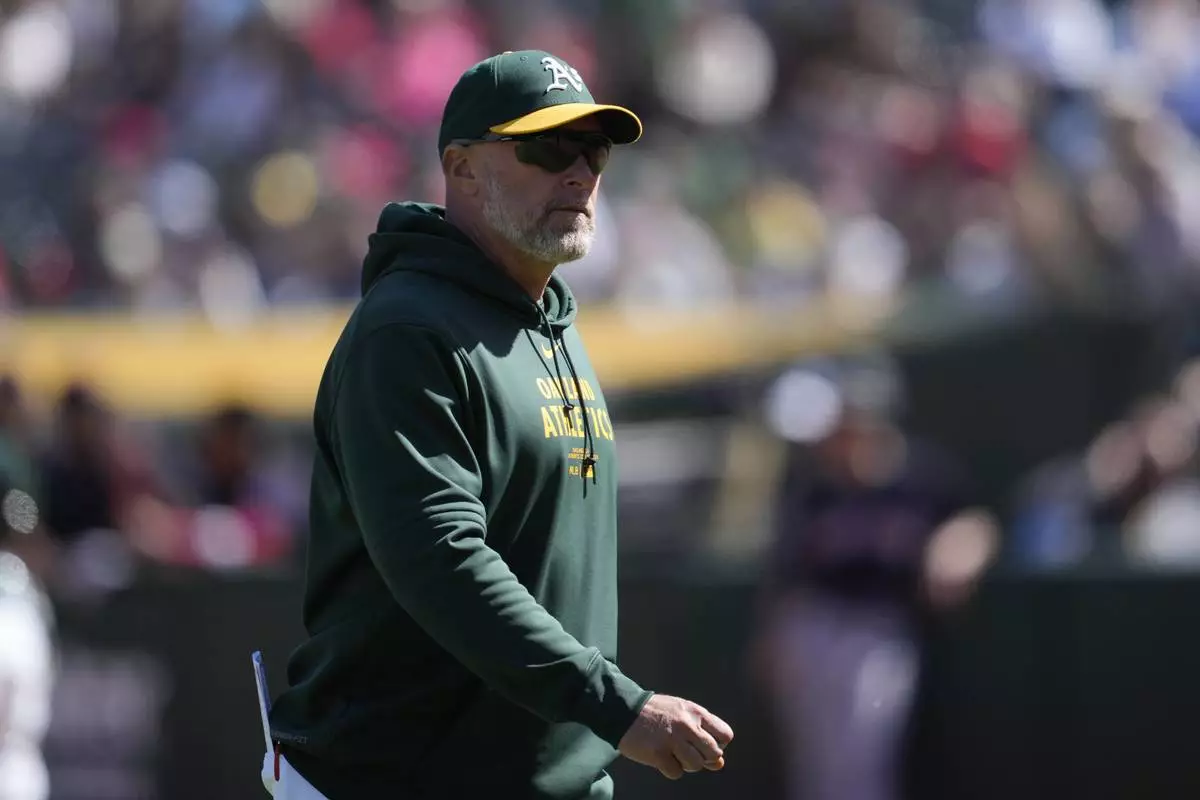As President Donald Trump seeks a nuclear deal with North Korean leader Kim Jong Un next week in Vietnam, some in Seoul are wondering if the fate of Washington's decades-long military alliance with South Korea could be at stake.
Much of this worry is linked to Trump's repeated assertions that the U.S. military deployment in South Korea is too costly, and to his surprise suspension of some U.S. military exercises with South Korea — including a major summertime drill — as a concession to Kim after their first summit in Singapore last year. Added to this concern are policies by South Korea's liberal President Moon Jae-in that critics say favor engagement with North Korea at the expense of the alliance with Washington.
The broader U.S.-South Korean alliance, sealed during the bloodshed of the 1950-53 Korean War, won't be on the negotiating table during the summit in Hanoi on Feb. 27-28. But some observers say its long-term future could be in doubt and that Trump may eventually withdraw some of the 28,500 U.S. troops deployed in South Korea.
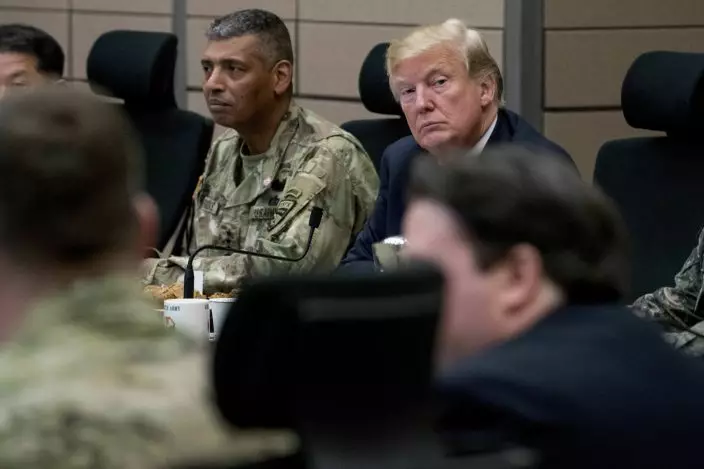
FILE - In this Nov. 7, 2017, file photo, U.S. President Donald Trump, accompanied by United States Forces Korea Commander Gen. Vincent Brooks, center left, attends an operational briefing at the eighth Army Operational Command Center at Camp Humphreys in Pyeongtaek, South Korea. Ahead of the second summit between Trump and North Korean leader Kim Jong Un, some observers say there is an uncertainty over the future of the decades-long military alliance between Washington and Seoul. (AP PhotoAndrew Harnik, File)
"The Korea-U.S. alliance is seriously ill now," Kim Taewoo, the former head of the government-funded Korea Institute for National Unification in South Korea, said in a recent speech.
U.S. and South Korean officials maintain that everything is fine.
After agreeing to increase its contribution to the cost of the U.S. military presence this year, South Korea's Foreign Ministry said last week that Washington insists it has no plans to adjust troop levels. During a phone call with Moon on Tuesday, Trump also said that U.S.-South Korea relations are better than ever, according to Moon's office.

FILE - In this March 25, 2015, file photo, U.S. Army soldiers from the 25th Infantry Division's 2nd Stryker Brigade Combat Team and South Korean soldiers take their position during a demonstration of the combined arms live-fire exercise as a part of the annual joint military exercise Foal Eagle between South Korea and the United States at the Rodriquez Multi-Purpose Range Complex in Pocheon, South Korea. Ahead of the second summit between U.S. President Donald Trump and North Korean leader Kim Jong Un, some observers say there is an uncertainty over the future of the decades-long military alliance between Washington and Seoul. (AP PhotoLee Jin-man, File)
Trump said earlier this month that he had no plans to withdraw troops, but he has previously threatened to pull them from South Korea and Japan if those nations refused to pay more. After the Singapore summit, Trump also told reporters: "I want to bring our soldiers (in South Korea) back home." While announcing the suspension of a major summertime military drill, Trump called the exercises "very provocative" and "tremendously expensive."
U.S. defense officials are not planning any troop reductions but some have indicated that they would not be surprised if Trump puts reductions on the table as part of his negotiations with Kim. Other possibilities that worry many in Seoul include that Trump will suspend or drastically downsize another major set of military drills this spring, or that he'll settle for a deal where the North abandons its long-range missile program aimed at the U.S. while not addressing the North's shorter-range missiles targeting Seoul and Tokyo.
An extended stoppage of comprehensive training between the allies could weaken the militaries' fighting capacity, especially since many U.S. soldiers rotate out of South Korea after less than a year of service, some experts say.
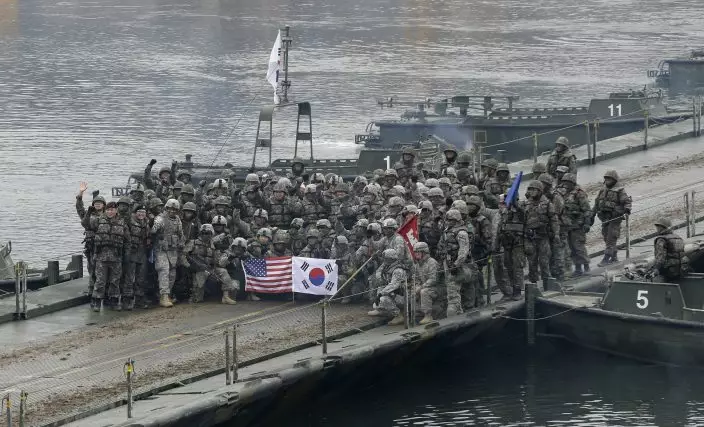
FILE - In this Dec. 10, 2015, file photo, U.S. and South Korean army soldiers pose on a floating bridge on the Hantan river after a river crossing operation, part of an annual joint military exercise between South Korea and the United States in Yeoncheon, south of the demilitarized zone that divides the two Koreas, South Korea. Ahead of the second summit between U.S. President Donald Trump and North Korean leader Kim Jong Un, some observers say there is an uncertainty over the future of the decades-long military alliance between Washington and Seoul. (AP PhotoAhn Young-joon, File)
"Soldiers' fighting power comes from training. If there aren't any (big) joint drills for one year, we'll have (U.S.) soldiers who have never experienced such drills," said Moon Seong Mook, an analyst for the Seoul-based Korea Research Institute for National Strategy.
North Korea, on the other hand, which has described the drills as preparation for invasion and responded with its own costly exercises, would likely benefit. North Korea has said it was forced to develop nuclear weapons to cope with what it calls American hostility.
During the Singapore summit, Kim said he was committed to the "complete denuclearization of the Korean Peninsula," which has previously meant the North would only denuclearize when the United States withdraws all its troops from South Korea and stops military drills with the South. In December, North Korea's state media said it would never unilaterally abandon its nuclear program unless Washington first removes its nuclear threat.
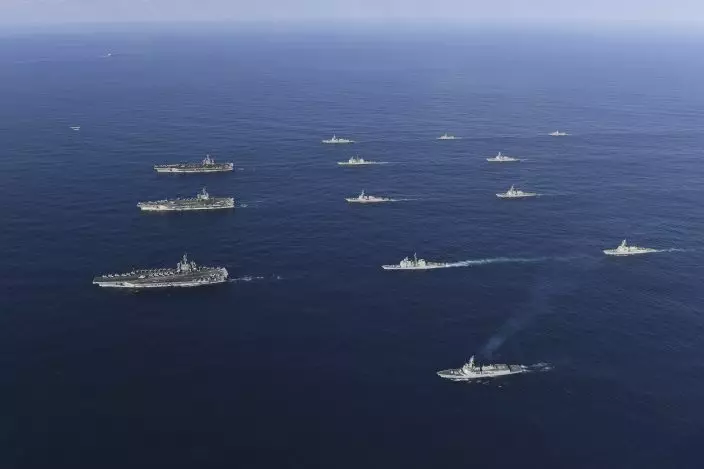
FILE - In this Nov. 12, 2017, file photo provided by South Korea Defense Ministry, three U.S. aircraft carriers USS Nimitz, left top, USS Ronald Reagan, left center, and USS Theodore Roosevelt, left bottom, participate with other U.S. and South Korean navy ships during the joint naval exercises between the United States and South Korea in waters off South Korea's eastern coast in South Korea. Ahead of the second summit between U.S. President Donald Trump and North Korean leader Kim Jong Un, some observers say there is an uncertainty over the future of the decades-long military alliance between Washington and Seoul. (South Korea Defense Ministry via AP, File)
Some are also concerned about reports that Trump may agree to declare the end of the Korean War, which ended with an armistice, as a security guarantee for the North. Such a declaration, considered as a preliminary step before signing a peace treaty to formally end the war, could provide the North with a basis to step up its calls for a U.S. troop pullout.
"If our security is shaken, foreign investments will be driven out of the country and stock prices will plummet," said the analyst Moon, a retired brigadier general who took part in numerous military talks with North Korea.
Part of the debate in South Korea reflects a deep historical division over the U.S. military.
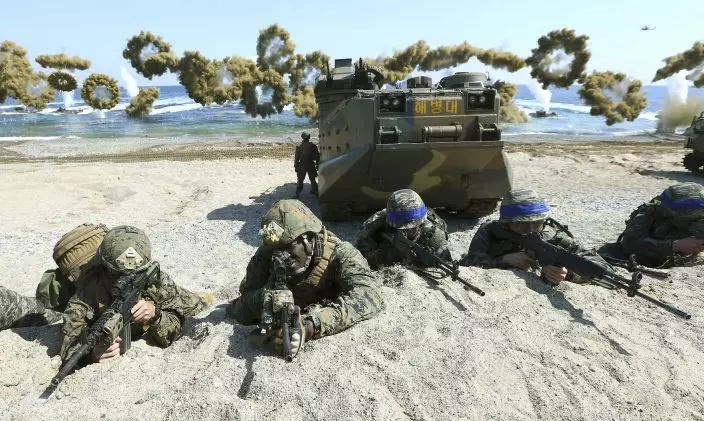
FILE - In this March 12, 2016, file photo, Marines of the U.S., left, and South Korea, wearing blue headbands on their helmets, take positions after landing on a beach during the joint military combined amphibious exercise, called Ssangyong, part of the Key Resolve and Foal Eagle military exercises, in Pohang, South Korea. Ahead of the second summit between U.S. President Donald Trump and North Korean leader Kim Jong Un, some observers say there is an uncertainty over the future of the decades-long military alliance between Washington and Seoul. (Kim Jun-bumYonhap via AP, File)
For some, the U.S. military rescued South Korea from the surprise North Korean invasion that started the Korean War. Others blame the United States for the 1945 division of the Korean Peninsula. Rallies that focus on the United States, both pro and anti, routinely take place in Seoul, but surveys show a majority of South Koreans support the U.S. troop deployment.
On Wednesday in a central Seoul neighborhood, placards that read "Let's protect the Korea-U.S. alliance, our lifeline, with our lives!" could be seen along with about 20 U.S. and South Korean flags. Nearby, about a dozen people rallied behind a banner calling for Washington not to threaten peace on the Korean Peninsula. "Are we America's colony?" one participant shouted.
Since the war, the U.S. has stationed tens of thousands of troops in South Korea to guard against North Korean attack. Meanwhile, South Korea has grown into an economically prosperous, faithful ally that has taken part in U.S.-led wars in Vietnam, Iraq and elsewhere.
U.S. troop numbers have gradually fallen over the decades.
After then President Richard Nixon withdrew about one third of the 60,000 U.S. troops in South Korea in 1971, South Korean President Park Chung-hee ordered officials to covertly pursue a nuclear weapons program, which was later scrapped because of fear of U.S. sanctions.
Former President Jimmy Carter, a critic of Park's suppression of human rights, sought to implement a campaign promise to bring back all 40,000 troops from South Korea. But he was opposed by many advisers and ended up bringing back about 3,000.
The departure of even several thousand U.S. troops could weaken the situation militarily because of the loss of both the soldiers and their weapons and equipment. But it could also hurt the U.S. military's efforts to counter a rising China.
"If (Trump) pulls back some of troops because of money issues ... he'd have more to lose than he'd gain," said analyst Kim Dong-yeop at the Institute for Far Eastern Studies in Seoul. "Under the viewpoint of a U.S.-China security framework, I wonder if (Trump's troop drawdown comments) are anything more than just rhetoric."
AP national security writer Robert Burns In Washington contributed to this report.






